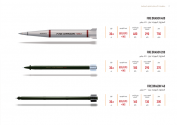Using the newest 150-km ranged 300mm projectiles, the PLAGF could theoretically hit ROC's Hsinchu Airbase and Hukou Army depot when firing from the edges of Pingtan Island. As with the 370mm projectiles, I don't think we know the exact range, except the export variant has a 220km range, which would be sufficient to cover most air bases around Taipei and Taoyuan.
The most recent export version of 370mm have 290km range.
The domestic version should be well in excess of 300km, people have thrown around 350km before which sounds reasonable to me.

